Victoria University: SAP S/4HANA Finance Research Report, 2018
VerifiedAdded on 2022/12/29
|12
|4571
|54
Report
AI Summary
This report provides a comprehensive analysis of SAP S/4HANA Finance, an updated ERP system designed for real-time data analysis and transaction processing. It begins with a historical overview, highlighting the evolution from SAP HANA to the current S/4HANA version. The report differentiates between SAP S/4HANA Finance and SAP ERP FICO, emphasizing the former's focus on financial management. Key benefits discussed include improved financial planning, real-time reporting, and enhanced decision-making capabilities. The report also presents case studies of companies like Wipro, IBM Services, and Delta Faucet, illustrating the challenges and successes of migrating to SAP S/4HANA Finance, including increased productivity, reduced costs, and improved financial insights. The report also emphasizes on the features like real-time analytics, and the implementation strategies for digital transformation. The report also discusses the benefits of using the SAP S/4 HANA version for the business.
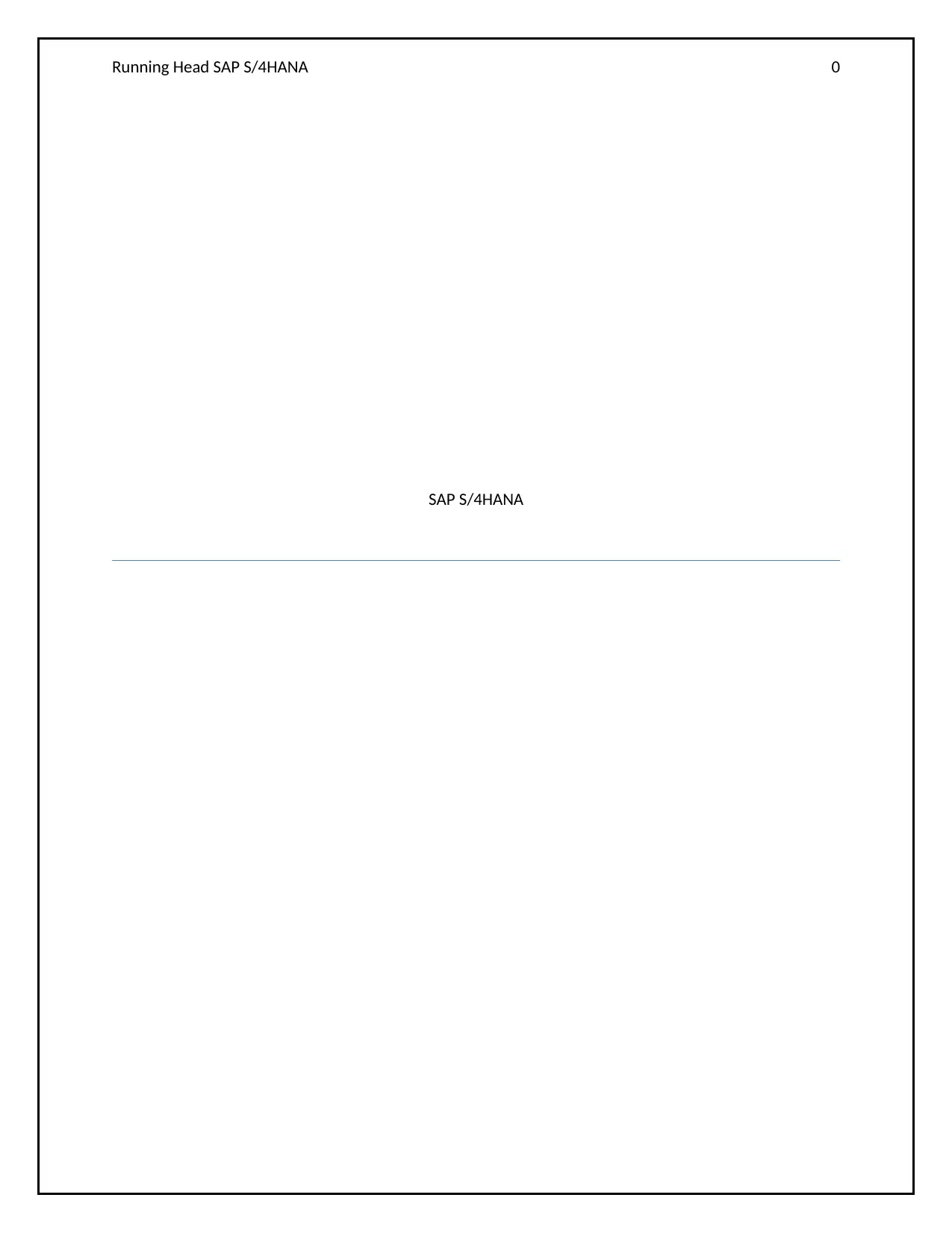
Running Head SAP S/4HANA 0
SAP S/4HANA
SAP S/4HANA
Paraphrase This Document
Need a fresh take? Get an instant paraphrase of this document with our AI Paraphraser
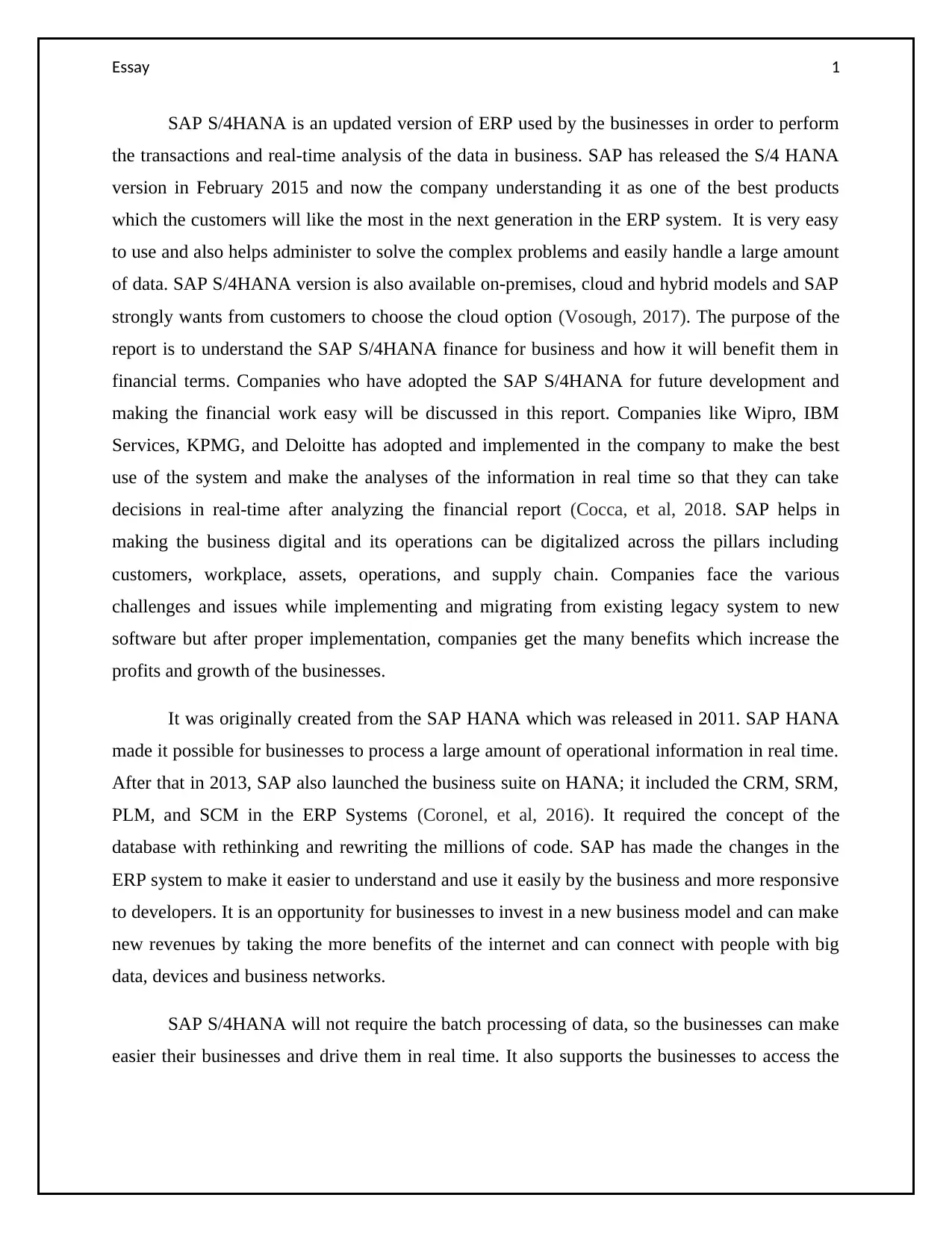
Essay 1
SAP S/4HANA is an updated version of ERP used by the businesses in order to perform
the transactions and real-time analysis of the data in business. SAP has released the S/4 HANA
version in February 2015 and now the company understanding it as one of the best products
which the customers will like the most in the next generation in the ERP system. It is very easy
to use and also helps administer to solve the complex problems and easily handle a large amount
of data. SAP S/4HANA version is also available on-premises, cloud and hybrid models and SAP
strongly wants from customers to choose the cloud option (Vosough, 2017). The purpose of the
report is to understand the SAP S/4HANA finance for business and how it will benefit them in
financial terms. Companies who have adopted the SAP S/4HANA for future development and
making the financial work easy will be discussed in this report. Companies like Wipro, IBM
Services, KPMG, and Deloitte has adopted and implemented in the company to make the best
use of the system and make the analyses of the information in real time so that they can take
decisions in real-time after analyzing the financial report (Cocca, et al, 2018. SAP helps in
making the business digital and its operations can be digitalized across the pillars including
customers, workplace, assets, operations, and supply chain. Companies face the various
challenges and issues while implementing and migrating from existing legacy system to new
software but after proper implementation, companies get the many benefits which increase the
profits and growth of the businesses.
It was originally created from the SAP HANA which was released in 2011. SAP HANA
made it possible for businesses to process a large amount of operational information in real time.
After that in 2013, SAP also launched the business suite on HANA; it included the CRM, SRM,
PLM, and SCM in the ERP Systems (Coronel, et al, 2016). It required the concept of the
database with rethinking and rewriting the millions of code. SAP has made the changes in the
ERP system to make it easier to understand and use it easily by the business and more responsive
to developers. It is an opportunity for businesses to invest in a new business model and can make
new revenues by taking the more benefits of the internet and can connect with people with big
data, devices and business networks.
SAP S/4HANA will not require the batch processing of data, so the businesses can make
easier their businesses and drive them in real time. It also supports the businesses to access the
SAP S/4HANA is an updated version of ERP used by the businesses in order to perform
the transactions and real-time analysis of the data in business. SAP has released the S/4 HANA
version in February 2015 and now the company understanding it as one of the best products
which the customers will like the most in the next generation in the ERP system. It is very easy
to use and also helps administer to solve the complex problems and easily handle a large amount
of data. SAP S/4HANA version is also available on-premises, cloud and hybrid models and SAP
strongly wants from customers to choose the cloud option (Vosough, 2017). The purpose of the
report is to understand the SAP S/4HANA finance for business and how it will benefit them in
financial terms. Companies who have adopted the SAP S/4HANA for future development and
making the financial work easy will be discussed in this report. Companies like Wipro, IBM
Services, KPMG, and Deloitte has adopted and implemented in the company to make the best
use of the system and make the analyses of the information in real time so that they can take
decisions in real-time after analyzing the financial report (Cocca, et al, 2018. SAP helps in
making the business digital and its operations can be digitalized across the pillars including
customers, workplace, assets, operations, and supply chain. Companies face the various
challenges and issues while implementing and migrating from existing legacy system to new
software but after proper implementation, companies get the many benefits which increase the
profits and growth of the businesses.
It was originally created from the SAP HANA which was released in 2011. SAP HANA
made it possible for businesses to process a large amount of operational information in real time.
After that in 2013, SAP also launched the business suite on HANA; it included the CRM, SRM,
PLM, and SCM in the ERP Systems (Coronel, et al, 2016). It required the concept of the
database with rethinking and rewriting the millions of code. SAP has made the changes in the
ERP system to make it easier to understand and use it easily by the business and more responsive
to developers. It is an opportunity for businesses to invest in a new business model and can make
new revenues by taking the more benefits of the internet and can connect with people with big
data, devices and business networks.
SAP S/4HANA will not require the batch processing of data, so the businesses can make
easier their businesses and drive them in real time. It also supports the businesses to access the
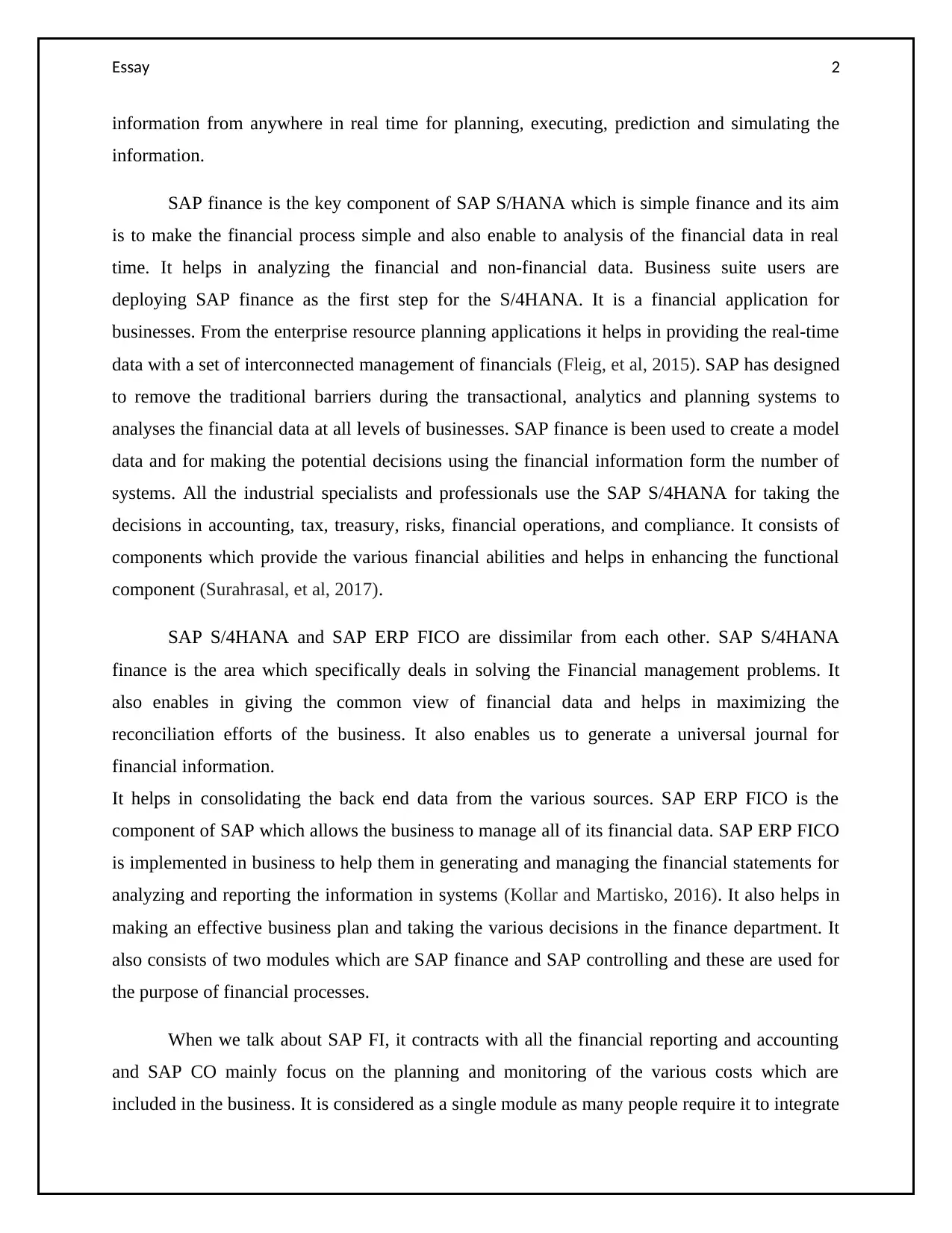
Essay 2
information from anywhere in real time for planning, executing, prediction and simulating the
information.
SAP finance is the key component of SAP S/HANA which is simple finance and its aim
is to make the financial process simple and also enable to analysis of the financial data in real
time. It helps in analyzing the financial and non-financial data. Business suite users are
deploying SAP finance as the first step for the S/4HANA. It is a financial application for
businesses. From the enterprise resource planning applications it helps in providing the real-time
data with a set of interconnected management of financials (Fleig, et al, 2015). SAP has designed
to remove the traditional barriers during the transactional, analytics and planning systems to
analyses the financial data at all levels of businesses. SAP finance is been used to create a model
data and for making the potential decisions using the financial information form the number of
systems. All the industrial specialists and professionals use the SAP S/4HANA for taking the
decisions in accounting, tax, treasury, risks, financial operations, and compliance. It consists of
components which provide the various financial abilities and helps in enhancing the functional
component (Surahrasal, et al, 2017).
SAP S/4HANA and SAP ERP FICO are dissimilar from each other. SAP S/4HANA
finance is the area which specifically deals in solving the Financial management problems. It
also enables in giving the common view of financial data and helps in maximizing the
reconciliation efforts of the business. It also enables us to generate a universal journal for
financial information.
It helps in consolidating the back end data from the various sources. SAP ERP FICO is the
component of SAP which allows the business to manage all of its financial data. SAP ERP FICO
is implemented in business to help them in generating and managing the financial statements for
analyzing and reporting the information in systems (Kollar and Martisko, 2016). It also helps in
making an effective business plan and taking the various decisions in the finance department. It
also consists of two modules which are SAP finance and SAP controlling and these are used for
the purpose of financial processes.
When we talk about SAP FI, it contracts with all the financial reporting and accounting
and SAP CO mainly focus on the planning and monitoring of the various costs which are
included in the business. It is considered as a single module as many people require it to integrate
information from anywhere in real time for planning, executing, prediction and simulating the
information.
SAP finance is the key component of SAP S/HANA which is simple finance and its aim
is to make the financial process simple and also enable to analysis of the financial data in real
time. It helps in analyzing the financial and non-financial data. Business suite users are
deploying SAP finance as the first step for the S/4HANA. It is a financial application for
businesses. From the enterprise resource planning applications it helps in providing the real-time
data with a set of interconnected management of financials (Fleig, et al, 2015). SAP has designed
to remove the traditional barriers during the transactional, analytics and planning systems to
analyses the financial data at all levels of businesses. SAP finance is been used to create a model
data and for making the potential decisions using the financial information form the number of
systems. All the industrial specialists and professionals use the SAP S/4HANA for taking the
decisions in accounting, tax, treasury, risks, financial operations, and compliance. It consists of
components which provide the various financial abilities and helps in enhancing the functional
component (Surahrasal, et al, 2017).
SAP S/4HANA and SAP ERP FICO are dissimilar from each other. SAP S/4HANA
finance is the area which specifically deals in solving the Financial management problems. It
also enables in giving the common view of financial data and helps in maximizing the
reconciliation efforts of the business. It also enables us to generate a universal journal for
financial information.
It helps in consolidating the back end data from the various sources. SAP ERP FICO is the
component of SAP which allows the business to manage all of its financial data. SAP ERP FICO
is implemented in business to help them in generating and managing the financial statements for
analyzing and reporting the information in systems (Kollar and Martisko, 2016). It also helps in
making an effective business plan and taking the various decisions in the finance department. It
also consists of two modules which are SAP finance and SAP controlling and these are used for
the purpose of financial processes.
When we talk about SAP FI, it contracts with all the financial reporting and accounting
and SAP CO mainly focus on the planning and monitoring of the various costs which are
included in the business. It is considered as a single module as many people require it to integrate
⊘ This is a preview!⊘
Do you want full access?
Subscribe today to unlock all pages.

Trusted by 1+ million students worldwide
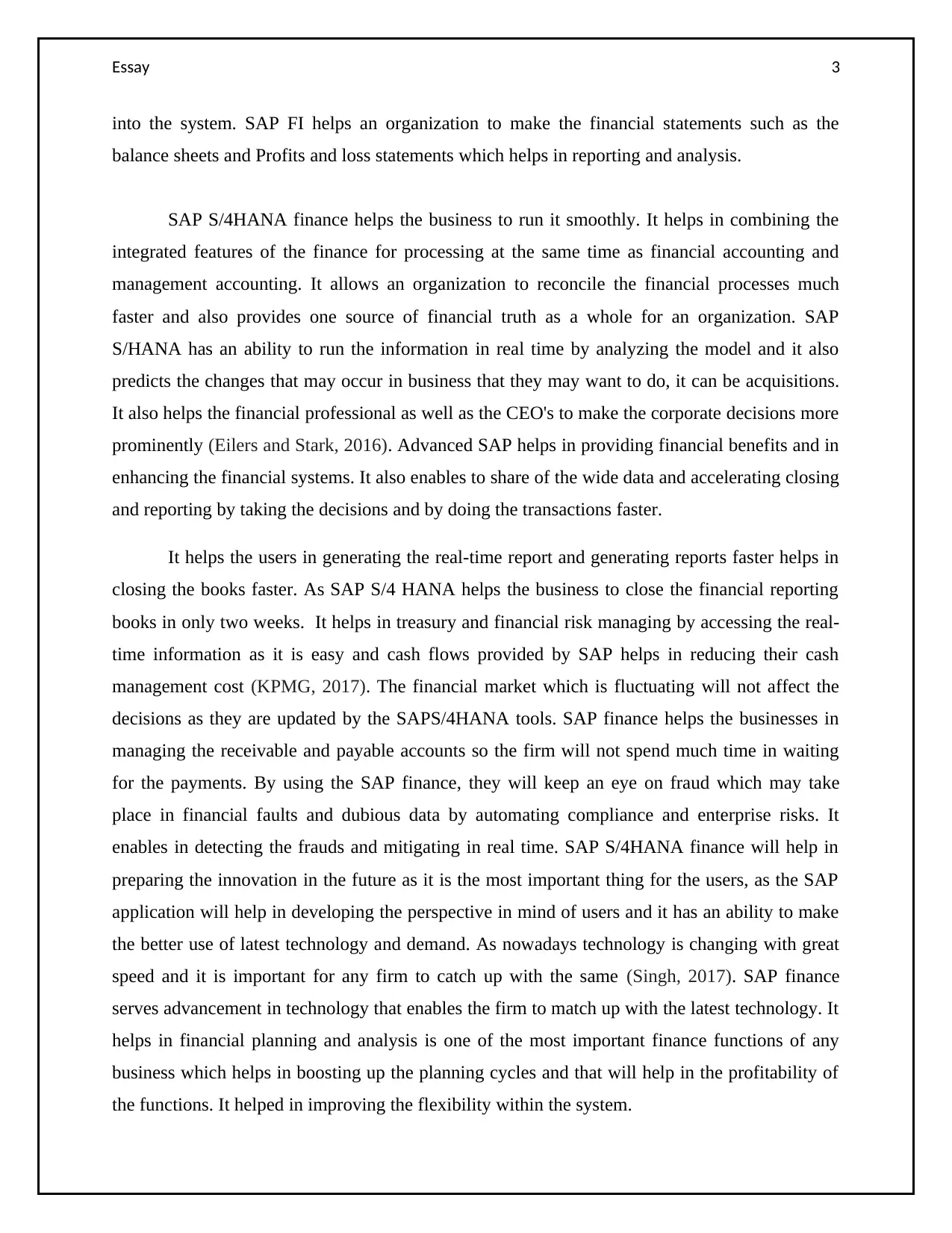
Essay 3
into the system. SAP FI helps an organization to make the financial statements such as the
balance sheets and Profits and loss statements which helps in reporting and analysis.
SAP S/4HANA finance helps the business to run it smoothly. It helps in combining the
integrated features of the finance for processing at the same time as financial accounting and
management accounting. It allows an organization to reconcile the financial processes much
faster and also provides one source of financial truth as a whole for an organization. SAP
S/HANA has an ability to run the information in real time by analyzing the model and it also
predicts the changes that may occur in business that they may want to do, it can be acquisitions.
It also helps the financial professional as well as the CEO's to make the corporate decisions more
prominently (Eilers and Stark, 2016). Advanced SAP helps in providing financial benefits and in
enhancing the financial systems. It also enables to share of the wide data and accelerating closing
and reporting by taking the decisions and by doing the transactions faster.
It helps the users in generating the real-time report and generating reports faster helps in
closing the books faster. As SAP S/4 HANA helps the business to close the financial reporting
books in only two weeks. It helps in treasury and financial risk managing by accessing the real-
time information as it is easy and cash flows provided by SAP helps in reducing their cash
management cost (KPMG, 2017). The financial market which is fluctuating will not affect the
decisions as they are updated by the SAPS/4HANA tools. SAP finance helps the businesses in
managing the receivable and payable accounts so the firm will not spend much time in waiting
for the payments. By using the SAP finance, they will keep an eye on fraud which may take
place in financial faults and dubious data by automating compliance and enterprise risks. It
enables in detecting the frauds and mitigating in real time. SAP S/4HANA finance will help in
preparing the innovation in the future as it is the most important thing for the users, as the SAP
application will help in developing the perspective in mind of users and it has an ability to make
the better use of latest technology and demand. As nowadays technology is changing with great
speed and it is important for any firm to catch up with the same (Singh, 2017). SAP finance
serves advancement in technology that enables the firm to match up with the latest technology. It
helps in financial planning and analysis is one of the most important finance functions of any
business which helps in boosting up the planning cycles and that will help in the profitability of
the functions. It helped in improving the flexibility within the system.
into the system. SAP FI helps an organization to make the financial statements such as the
balance sheets and Profits and loss statements which helps in reporting and analysis.
SAP S/4HANA finance helps the business to run it smoothly. It helps in combining the
integrated features of the finance for processing at the same time as financial accounting and
management accounting. It allows an organization to reconcile the financial processes much
faster and also provides one source of financial truth as a whole for an organization. SAP
S/HANA has an ability to run the information in real time by analyzing the model and it also
predicts the changes that may occur in business that they may want to do, it can be acquisitions.
It also helps the financial professional as well as the CEO's to make the corporate decisions more
prominently (Eilers and Stark, 2016). Advanced SAP helps in providing financial benefits and in
enhancing the financial systems. It also enables to share of the wide data and accelerating closing
and reporting by taking the decisions and by doing the transactions faster.
It helps the users in generating the real-time report and generating reports faster helps in
closing the books faster. As SAP S/4 HANA helps the business to close the financial reporting
books in only two weeks. It helps in treasury and financial risk managing by accessing the real-
time information as it is easy and cash flows provided by SAP helps in reducing their cash
management cost (KPMG, 2017). The financial market which is fluctuating will not affect the
decisions as they are updated by the SAPS/4HANA tools. SAP finance helps the businesses in
managing the receivable and payable accounts so the firm will not spend much time in waiting
for the payments. By using the SAP finance, they will keep an eye on fraud which may take
place in financial faults and dubious data by automating compliance and enterprise risks. It
enables in detecting the frauds and mitigating in real time. SAP S/4HANA finance will help in
preparing the innovation in the future as it is the most important thing for the users, as the SAP
application will help in developing the perspective in mind of users and it has an ability to make
the better use of latest technology and demand. As nowadays technology is changing with great
speed and it is important for any firm to catch up with the same (Singh, 2017). SAP finance
serves advancement in technology that enables the firm to match up with the latest technology. It
helps in financial planning and analysis is one of the most important finance functions of any
business which helps in boosting up the planning cycles and that will help in the profitability of
the functions. It helped in improving the flexibility within the system.
Paraphrase This Document
Need a fresh take? Get an instant paraphrase of this document with our AI Paraphraser
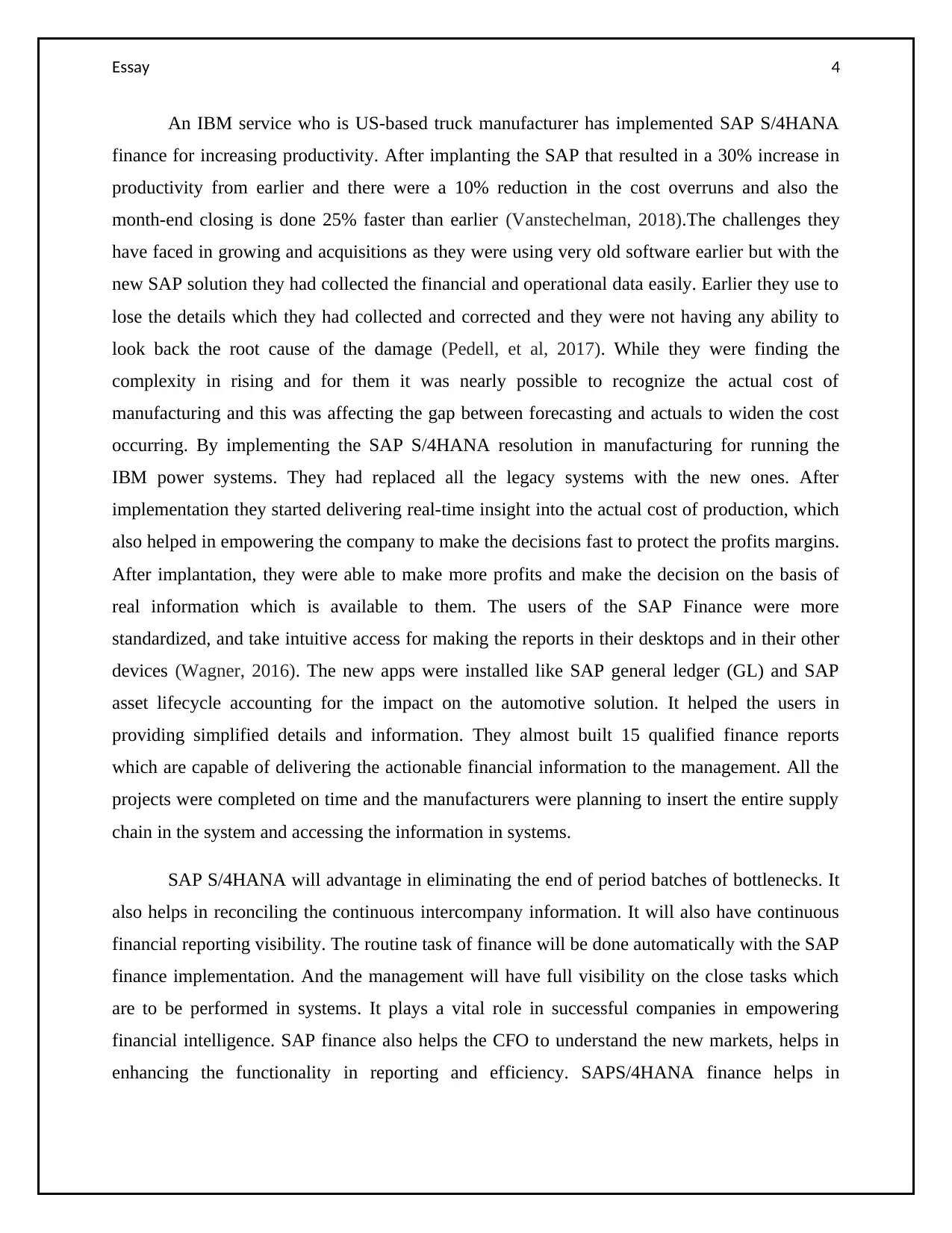
Essay 4
An IBM service who is US-based truck manufacturer has implemented SAP S/4HANA
finance for increasing productivity. After implanting the SAP that resulted in a 30% increase in
productivity from earlier and there were a 10% reduction in the cost overruns and also the
month-end closing is done 25% faster than earlier (Vanstechelman, 2018).The challenges they
have faced in growing and acquisitions as they were using very old software earlier but with the
new SAP solution they had collected the financial and operational data easily. Earlier they use to
lose the details which they had collected and corrected and they were not having any ability to
look back the root cause of the damage (Pedell, et al, 2017). While they were finding the
complexity in rising and for them it was nearly possible to recognize the actual cost of
manufacturing and this was affecting the gap between forecasting and actuals to widen the cost
occurring. By implementing the SAP S/4HANA resolution in manufacturing for running the
IBM power systems. They had replaced all the legacy systems with the new ones. After
implementation they started delivering real-time insight into the actual cost of production, which
also helped in empowering the company to make the decisions fast to protect the profits margins.
After implantation, they were able to make more profits and make the decision on the basis of
real information which is available to them. The users of the SAP Finance were more
standardized, and take intuitive access for making the reports in their desktops and in their other
devices (Wagner, 2016). The new apps were installed like SAP general ledger (GL) and SAP
asset lifecycle accounting for the impact on the automotive solution. It helped the users in
providing simplified details and information. They almost built 15 qualified finance reports
which are capable of delivering the actionable financial information to the management. All the
projects were completed on time and the manufacturers were planning to insert the entire supply
chain in the system and accessing the information in systems.
SAP S/4HANA will advantage in eliminating the end of period batches of bottlenecks. It
also helps in reconciling the continuous intercompany information. It will also have continuous
financial reporting visibility. The routine task of finance will be done automatically with the SAP
finance implementation. And the management will have full visibility on the close tasks which
are to be performed in systems. It plays a vital role in successful companies in empowering
financial intelligence. SAP finance also helps the CFO to understand the new markets, helps in
enhancing the functionality in reporting and efficiency. SAPS/4HANA finance helps in
An IBM service who is US-based truck manufacturer has implemented SAP S/4HANA
finance for increasing productivity. After implanting the SAP that resulted in a 30% increase in
productivity from earlier and there were a 10% reduction in the cost overruns and also the
month-end closing is done 25% faster than earlier (Vanstechelman, 2018).The challenges they
have faced in growing and acquisitions as they were using very old software earlier but with the
new SAP solution they had collected the financial and operational data easily. Earlier they use to
lose the details which they had collected and corrected and they were not having any ability to
look back the root cause of the damage (Pedell, et al, 2017). While they were finding the
complexity in rising and for them it was nearly possible to recognize the actual cost of
manufacturing and this was affecting the gap between forecasting and actuals to widen the cost
occurring. By implementing the SAP S/4HANA resolution in manufacturing for running the
IBM power systems. They had replaced all the legacy systems with the new ones. After
implementation they started delivering real-time insight into the actual cost of production, which
also helped in empowering the company to make the decisions fast to protect the profits margins.
After implantation, they were able to make more profits and make the decision on the basis of
real information which is available to them. The users of the SAP Finance were more
standardized, and take intuitive access for making the reports in their desktops and in their other
devices (Wagner, 2016). The new apps were installed like SAP general ledger (GL) and SAP
asset lifecycle accounting for the impact on the automotive solution. It helped the users in
providing simplified details and information. They almost built 15 qualified finance reports
which are capable of delivering the actionable financial information to the management. All the
projects were completed on time and the manufacturers were planning to insert the entire supply
chain in the system and accessing the information in systems.
SAP S/4HANA will advantage in eliminating the end of period batches of bottlenecks. It
also helps in reconciling the continuous intercompany information. It will also have continuous
financial reporting visibility. The routine task of finance will be done automatically with the SAP
finance implementation. And the management will have full visibility on the close tasks which
are to be performed in systems. It plays a vital role in successful companies in empowering
financial intelligence. SAP finance also helps the CFO to understand the new markets, helps in
enhancing the functionality in reporting and efficiency. SAPS/4HANA finance helps in
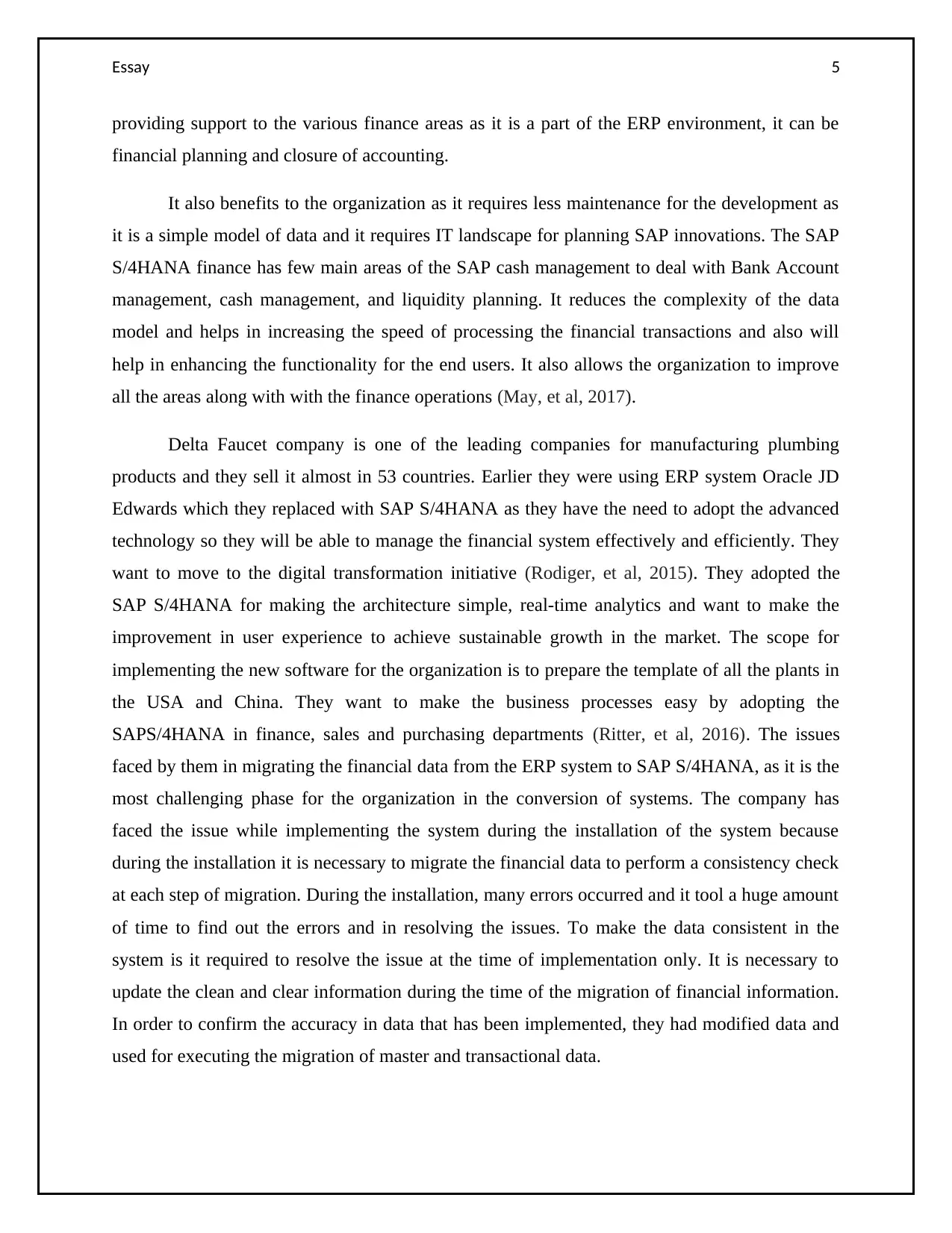
Essay 5
providing support to the various finance areas as it is a part of the ERP environment, it can be
financial planning and closure of accounting.
It also benefits to the organization as it requires less maintenance for the development as
it is a simple model of data and it requires IT landscape for planning SAP innovations. The SAP
S/4HANA finance has few main areas of the SAP cash management to deal with Bank Account
management, cash management, and liquidity planning. It reduces the complexity of the data
model and helps in increasing the speed of processing the financial transactions and also will
help in enhancing the functionality for the end users. It also allows the organization to improve
all the areas along with with the finance operations (May, et al, 2017).
Delta Faucet company is one of the leading companies for manufacturing plumbing
products and they sell it almost in 53 countries. Earlier they were using ERP system Oracle JD
Edwards which they replaced with SAP S/4HANA as they have the need to adopt the advanced
technology so they will be able to manage the financial system effectively and efficiently. They
want to move to the digital transformation initiative (Rodiger, et al, 2015). They adopted the
SAP S/4HANA for making the architecture simple, real-time analytics and want to make the
improvement in user experience to achieve sustainable growth in the market. The scope for
implementing the new software for the organization is to prepare the template of all the plants in
the USA and China. They want to make the business processes easy by adopting the
SAPS/4HANA in finance, sales and purchasing departments (Ritter, et al, 2016). The issues
faced by them in migrating the financial data from the ERP system to SAP S/4HANA, as it is the
most challenging phase for the organization in the conversion of systems. The company has
faced the issue while implementing the system during the installation of the system because
during the installation it is necessary to migrate the financial data to perform a consistency check
at each step of migration. During the installation, many errors occurred and it tool a huge amount
of time to find out the errors and in resolving the issues. To make the data consistent in the
system is it required to resolve the issue at the time of implementation only. It is necessary to
update the clean and clear information during the time of the migration of financial information.
In order to confirm the accuracy in data that has been implemented, they had modified data and
used for executing the migration of master and transactional data.
providing support to the various finance areas as it is a part of the ERP environment, it can be
financial planning and closure of accounting.
It also benefits to the organization as it requires less maintenance for the development as
it is a simple model of data and it requires IT landscape for planning SAP innovations. The SAP
S/4HANA finance has few main areas of the SAP cash management to deal with Bank Account
management, cash management, and liquidity planning. It reduces the complexity of the data
model and helps in increasing the speed of processing the financial transactions and also will
help in enhancing the functionality for the end users. It also allows the organization to improve
all the areas along with with the finance operations (May, et al, 2017).
Delta Faucet company is one of the leading companies for manufacturing plumbing
products and they sell it almost in 53 countries. Earlier they were using ERP system Oracle JD
Edwards which they replaced with SAP S/4HANA as they have the need to adopt the advanced
technology so they will be able to manage the financial system effectively and efficiently. They
want to move to the digital transformation initiative (Rodiger, et al, 2015). They adopted the
SAP S/4HANA for making the architecture simple, real-time analytics and want to make the
improvement in user experience to achieve sustainable growth in the market. The scope for
implementing the new software for the organization is to prepare the template of all the plants in
the USA and China. They want to make the business processes easy by adopting the
SAPS/4HANA in finance, sales and purchasing departments (Ritter, et al, 2016). The issues
faced by them in migrating the financial data from the ERP system to SAP S/4HANA, as it is the
most challenging phase for the organization in the conversion of systems. The company has
faced the issue while implementing the system during the installation of the system because
during the installation it is necessary to migrate the financial data to perform a consistency check
at each step of migration. During the installation, many errors occurred and it tool a huge amount
of time to find out the errors and in resolving the issues. To make the data consistent in the
system is it required to resolve the issue at the time of implementation only. It is necessary to
update the clean and clear information during the time of the migration of financial information.
In order to confirm the accuracy in data that has been implemented, they had modified data and
used for executing the migration of master and transactional data.
⊘ This is a preview!⊘
Do you want full access?
Subscribe today to unlock all pages.

Trusted by 1+ million students worldwide
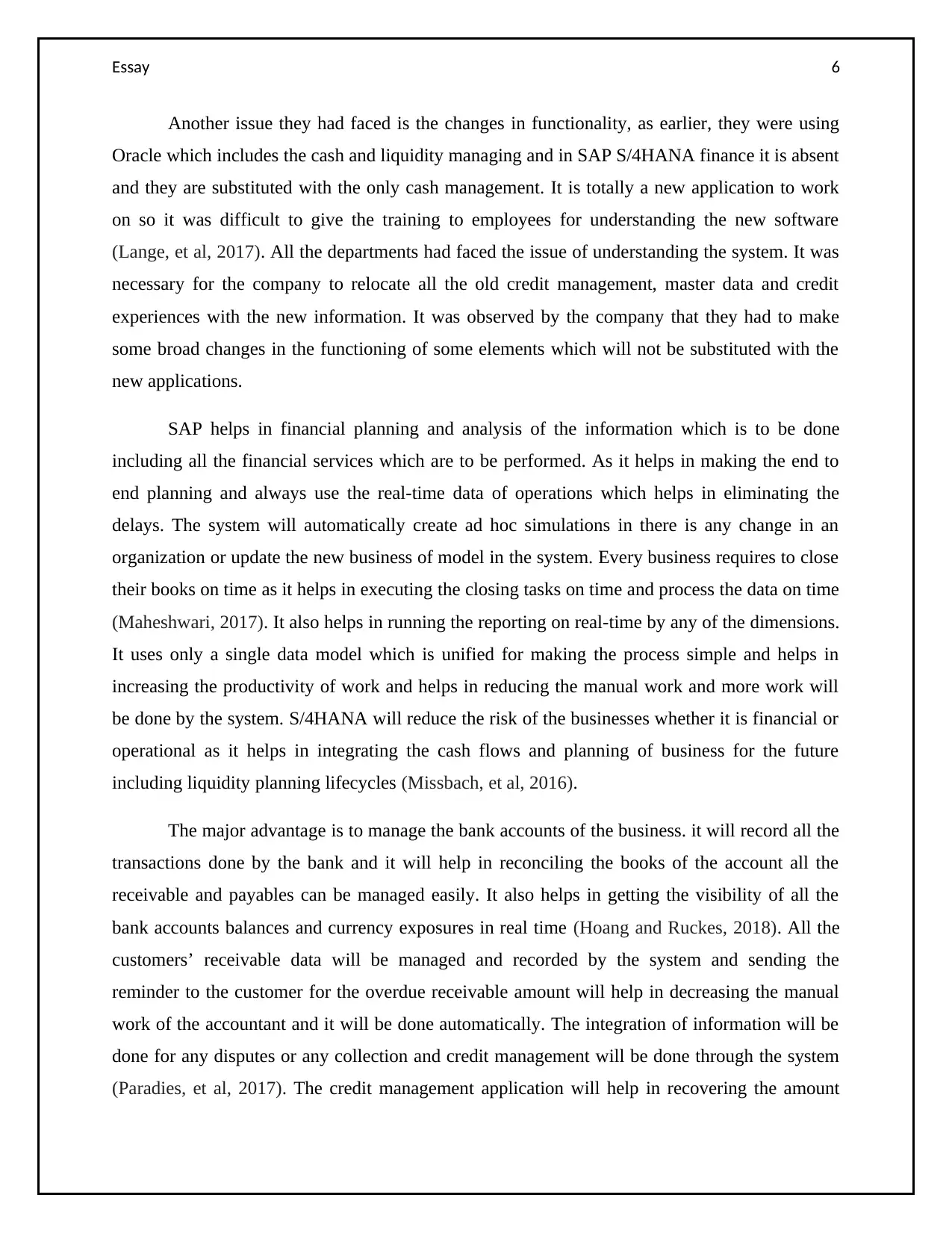
Essay 6
Another issue they had faced is the changes in functionality, as earlier, they were using
Oracle which includes the cash and liquidity managing and in SAP S/4HANA finance it is absent
and they are substituted with the only cash management. It is totally a new application to work
on so it was difficult to give the training to employees for understanding the new software
(Lange, et al, 2017). All the departments had faced the issue of understanding the system. It was
necessary for the company to relocate all the old credit management, master data and credit
experiences with the new information. It was observed by the company that they had to make
some broad changes in the functioning of some elements which will not be substituted with the
new applications.
SAP helps in financial planning and analysis of the information which is to be done
including all the financial services which are to be performed. As it helps in making the end to
end planning and always use the real-time data of operations which helps in eliminating the
delays. The system will automatically create ad hoc simulations in there is any change in an
organization or update the new business of model in the system. Every business requires to close
their books on time as it helps in executing the closing tasks on time and process the data on time
(Maheshwari, 2017). It also helps in running the reporting on real-time by any of the dimensions.
It uses only a single data model which is unified for making the process simple and helps in
increasing the productivity of work and helps in reducing the manual work and more work will
be done by the system. S/4HANA will reduce the risk of the businesses whether it is financial or
operational as it helps in integrating the cash flows and planning of business for the future
including liquidity planning lifecycles (Missbach, et al, 2016).
The major advantage is to manage the bank accounts of the business. it will record all the
transactions done by the bank and it will help in reconciling the books of the account all the
receivable and payables can be managed easily. It also helps in getting the visibility of all the
bank accounts balances and currency exposures in real time (Hoang and Ruckes, 2018). All the
customers’ receivable data will be managed and recorded by the system and sending the
reminder to the customer for the overdue receivable amount will help in decreasing the manual
work of the accountant and it will be done automatically. The integration of information will be
done for any disputes or any collection and credit management will be done through the system
(Paradies, et al, 2017). The credit management application will help in recovering the amount
Another issue they had faced is the changes in functionality, as earlier, they were using
Oracle which includes the cash and liquidity managing and in SAP S/4HANA finance it is absent
and they are substituted with the only cash management. It is totally a new application to work
on so it was difficult to give the training to employees for understanding the new software
(Lange, et al, 2017). All the departments had faced the issue of understanding the system. It was
necessary for the company to relocate all the old credit management, master data and credit
experiences with the new information. It was observed by the company that they had to make
some broad changes in the functioning of some elements which will not be substituted with the
new applications.
SAP helps in financial planning and analysis of the information which is to be done
including all the financial services which are to be performed. As it helps in making the end to
end planning and always use the real-time data of operations which helps in eliminating the
delays. The system will automatically create ad hoc simulations in there is any change in an
organization or update the new business of model in the system. Every business requires to close
their books on time as it helps in executing the closing tasks on time and process the data on time
(Maheshwari, 2017). It also helps in running the reporting on real-time by any of the dimensions.
It uses only a single data model which is unified for making the process simple and helps in
increasing the productivity of work and helps in reducing the manual work and more work will
be done by the system. S/4HANA will reduce the risk of the businesses whether it is financial or
operational as it helps in integrating the cash flows and planning of business for the future
including liquidity planning lifecycles (Missbach, et al, 2016).
The major advantage is to manage the bank accounts of the business. it will record all the
transactions done by the bank and it will help in reconciling the books of the account all the
receivable and payables can be managed easily. It also helps in getting the visibility of all the
bank accounts balances and currency exposures in real time (Hoang and Ruckes, 2018). All the
customers’ receivable data will be managed and recorded by the system and sending the
reminder to the customer for the overdue receivable amount will help in decreasing the manual
work of the accountant and it will be done automatically. The integration of information will be
done for any disputes or any collection and credit management will be done through the system
(Paradies, et al, 2017). The credit management application will help in recovering the amount
Paraphrase This Document
Need a fresh take? Get an instant paraphrase of this document with our AI Paraphraser
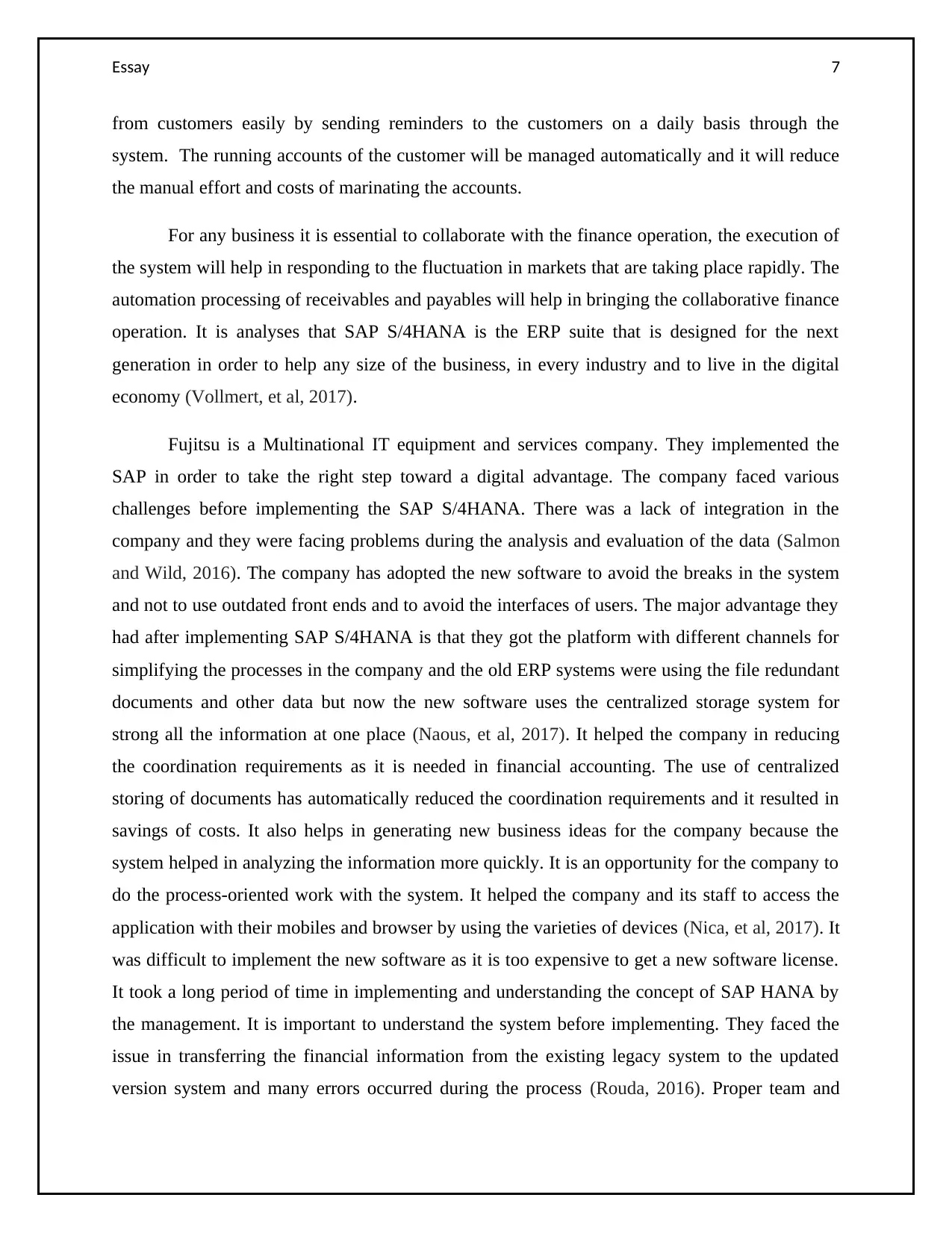
Essay 7
from customers easily by sending reminders to the customers on a daily basis through the
system. The running accounts of the customer will be managed automatically and it will reduce
the manual effort and costs of marinating the accounts.
For any business it is essential to collaborate with the finance operation, the execution of
the system will help in responding to the fluctuation in markets that are taking place rapidly. The
automation processing of receivables and payables will help in bringing the collaborative finance
operation. It is analyses that SAP S/4HANA is the ERP suite that is designed for the next
generation in order to help any size of the business, in every industry and to live in the digital
economy (Vollmert, et al, 2017).
Fujitsu is a Multinational IT equipment and services company. They implemented the
SAP in order to take the right step toward a digital advantage. The company faced various
challenges before implementing the SAP S/4HANA. There was a lack of integration in the
company and they were facing problems during the analysis and evaluation of the data (Salmon
and Wild, 2016). The company has adopted the new software to avoid the breaks in the system
and not to use outdated front ends and to avoid the interfaces of users. The major advantage they
had after implementing SAP S/4HANA is that they got the platform with different channels for
simplifying the processes in the company and the old ERP systems were using the file redundant
documents and other data but now the new software uses the centralized storage system for
strong all the information at one place (Naous, et al, 2017). It helped the company in reducing
the coordination requirements as it is needed in financial accounting. The use of centralized
storing of documents has automatically reduced the coordination requirements and it resulted in
savings of costs. It also helps in generating new business ideas for the company because the
system helped in analyzing the information more quickly. It is an opportunity for the company to
do the process-oriented work with the system. It helped the company and its staff to access the
application with their mobiles and browser by using the varieties of devices (Nica, et al, 2017). It
was difficult to implement the new software as it is too expensive to get a new software license.
It took a long period of time in implementing and understanding the concept of SAP HANA by
the management. It is important to understand the system before implementing. They faced the
issue in transferring the financial information from the existing legacy system to the updated
version system and many errors occurred during the process (Rouda, 2016). Proper team and
from customers easily by sending reminders to the customers on a daily basis through the
system. The running accounts of the customer will be managed automatically and it will reduce
the manual effort and costs of marinating the accounts.
For any business it is essential to collaborate with the finance operation, the execution of
the system will help in responding to the fluctuation in markets that are taking place rapidly. The
automation processing of receivables and payables will help in bringing the collaborative finance
operation. It is analyses that SAP S/4HANA is the ERP suite that is designed for the next
generation in order to help any size of the business, in every industry and to live in the digital
economy (Vollmert, et al, 2017).
Fujitsu is a Multinational IT equipment and services company. They implemented the
SAP in order to take the right step toward a digital advantage. The company faced various
challenges before implementing the SAP S/4HANA. There was a lack of integration in the
company and they were facing problems during the analysis and evaluation of the data (Salmon
and Wild, 2016). The company has adopted the new software to avoid the breaks in the system
and not to use outdated front ends and to avoid the interfaces of users. The major advantage they
had after implementing SAP S/4HANA is that they got the platform with different channels for
simplifying the processes in the company and the old ERP systems were using the file redundant
documents and other data but now the new software uses the centralized storage system for
strong all the information at one place (Naous, et al, 2017). It helped the company in reducing
the coordination requirements as it is needed in financial accounting. The use of centralized
storing of documents has automatically reduced the coordination requirements and it resulted in
savings of costs. It also helps in generating new business ideas for the company because the
system helped in analyzing the information more quickly. It is an opportunity for the company to
do the process-oriented work with the system. It helped the company and its staff to access the
application with their mobiles and browser by using the varieties of devices (Nica, et al, 2017). It
was difficult to implement the new software as it is too expensive to get a new software license.
It took a long period of time in implementing and understanding the concept of SAP HANA by
the management. It is important to understand the system before implementing. They faced the
issue in transferring the financial information from the existing legacy system to the updated
version system and many errors occurred during the process (Rouda, 2016). Proper team and
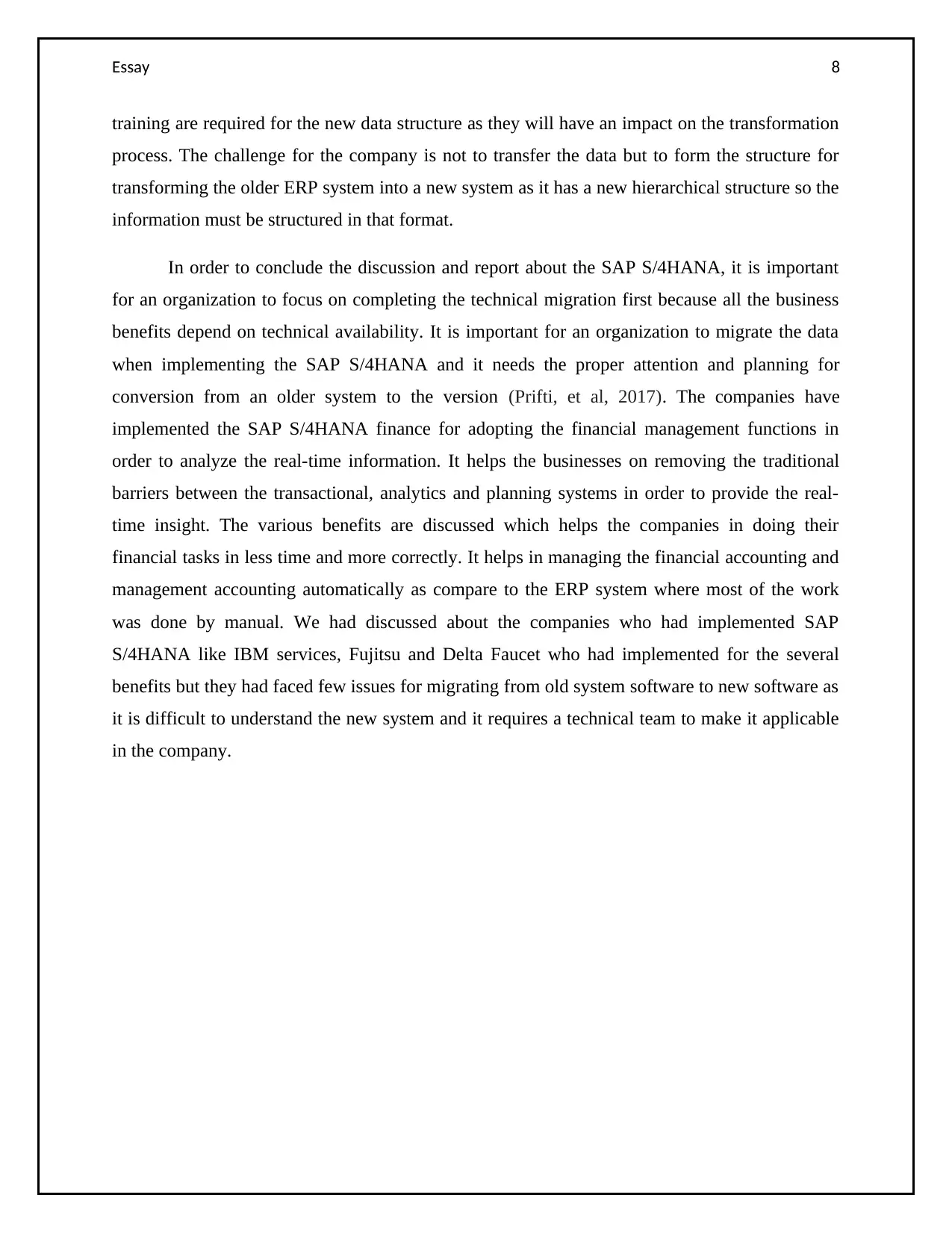
Essay 8
training are required for the new data structure as they will have an impact on the transformation
process. The challenge for the company is not to transfer the data but to form the structure for
transforming the older ERP system into a new system as it has a new hierarchical structure so the
information must be structured in that format.
In order to conclude the discussion and report about the SAP S/4HANA, it is important
for an organization to focus on completing the technical migration first because all the business
benefits depend on technical availability. It is important for an organization to migrate the data
when implementing the SAP S/4HANA and it needs the proper attention and planning for
conversion from an older system to the version (Prifti, et al, 2017). The companies have
implemented the SAP S/4HANA finance for adopting the financial management functions in
order to analyze the real-time information. It helps the businesses on removing the traditional
barriers between the transactional, analytics and planning systems in order to provide the real-
time insight. The various benefits are discussed which helps the companies in doing their
financial tasks in less time and more correctly. It helps in managing the financial accounting and
management accounting automatically as compare to the ERP system where most of the work
was done by manual. We had discussed about the companies who had implemented SAP
S/4HANA like IBM services, Fujitsu and Delta Faucet who had implemented for the several
benefits but they had faced few issues for migrating from old system software to new software as
it is difficult to understand the new system and it requires a technical team to make it applicable
in the company.
training are required for the new data structure as they will have an impact on the transformation
process. The challenge for the company is not to transfer the data but to form the structure for
transforming the older ERP system into a new system as it has a new hierarchical structure so the
information must be structured in that format.
In order to conclude the discussion and report about the SAP S/4HANA, it is important
for an organization to focus on completing the technical migration first because all the business
benefits depend on technical availability. It is important for an organization to migrate the data
when implementing the SAP S/4HANA and it needs the proper attention and planning for
conversion from an older system to the version (Prifti, et al, 2017). The companies have
implemented the SAP S/4HANA finance for adopting the financial management functions in
order to analyze the real-time information. It helps the businesses on removing the traditional
barriers between the transactional, analytics and planning systems in order to provide the real-
time insight. The various benefits are discussed which helps the companies in doing their
financial tasks in less time and more correctly. It helps in managing the financial accounting and
management accounting automatically as compare to the ERP system where most of the work
was done by manual. We had discussed about the companies who had implemented SAP
S/4HANA like IBM services, Fujitsu and Delta Faucet who had implemented for the several
benefits but they had faced few issues for migrating from old system software to new software as
it is difficult to understand the new system and it requires a technical team to make it applicable
in the company.
⊘ This is a preview!⊘
Do you want full access?
Subscribe today to unlock all pages.

Trusted by 1+ million students worldwide
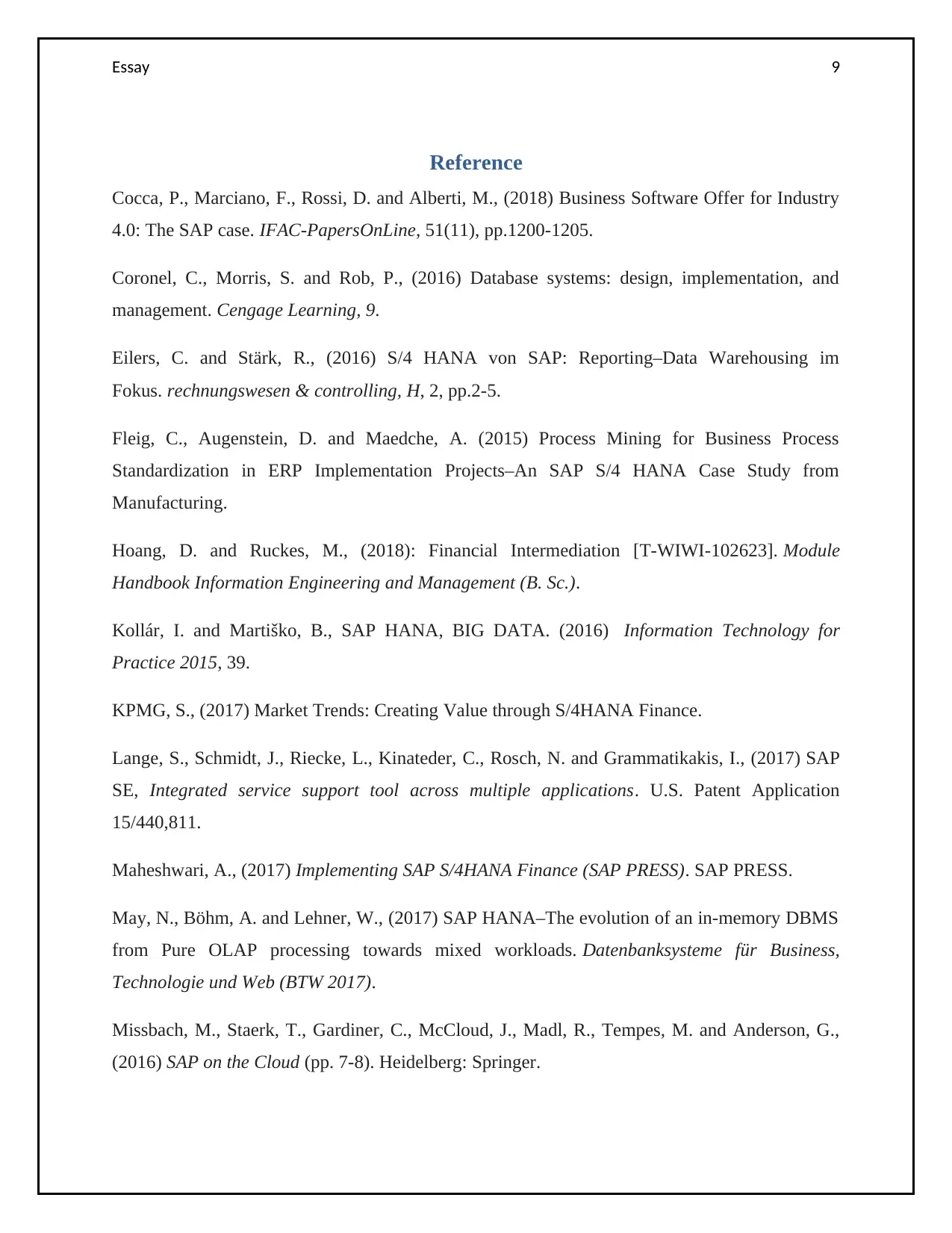
Essay 9
Reference
Cocca, P., Marciano, F., Rossi, D. and Alberti, M., (2018) Business Software Offer for Industry
4.0: The SAP case. IFAC-PapersOnLine, 51(11), pp.1200-1205.
Coronel, C., Morris, S. and Rob, P., (2016) Database systems: design, implementation, and
management. Cengage Learning, 9.
Eilers, C. and Stärk, R., (2016) S/4 HANA von SAP: Reporting–Data Warehousing im
Fokus. rechnungswesen & controlling, H, 2, pp.2-5.
Fleig, C., Augenstein, D. and Maedche, A. (2015) Process Mining for Business Process
Standardization in ERP Implementation Projects–An SAP S/4 HANA Case Study from
Manufacturing.
Hoang, D. and Ruckes, M., (2018): Financial Intermediation [T-WIWI-102623]. Module
Handbook Information Engineering and Management (B. Sc.).
Kollár, I. and Martiško, B., SAP HANA, BIG DATA. (2016) Information Technology for
Practice 2015, 39.
KPMG, S., (2017) Market Trends: Creating Value through S/4HANA Finance.
Lange, S., Schmidt, J., Riecke, L., Kinateder, C., Rosch, N. and Grammatikakis, I., (2017) SAP
SE, Integrated service support tool across multiple applications. U.S. Patent Application
15/440,811.
Maheshwari, A., (2017) Implementing SAP S/4HANA Finance (SAP PRESS). SAP PRESS.
May, N., Böhm, A. and Lehner, W., (2017) SAP HANA–The evolution of an in-memory DBMS
from Pure OLAP processing towards mixed workloads. Datenbanksysteme für Business,
Technologie und Web (BTW 2017).
Missbach, M., Staerk, T., Gardiner, C., McCloud, J., Madl, R., Tempes, M. and Anderson, G.,
(2016) SAP on the Cloud (pp. 7-8). Heidelberg: Springer.
Reference
Cocca, P., Marciano, F., Rossi, D. and Alberti, M., (2018) Business Software Offer for Industry
4.0: The SAP case. IFAC-PapersOnLine, 51(11), pp.1200-1205.
Coronel, C., Morris, S. and Rob, P., (2016) Database systems: design, implementation, and
management. Cengage Learning, 9.
Eilers, C. and Stärk, R., (2016) S/4 HANA von SAP: Reporting–Data Warehousing im
Fokus. rechnungswesen & controlling, H, 2, pp.2-5.
Fleig, C., Augenstein, D. and Maedche, A. (2015) Process Mining for Business Process
Standardization in ERP Implementation Projects–An SAP S/4 HANA Case Study from
Manufacturing.
Hoang, D. and Ruckes, M., (2018): Financial Intermediation [T-WIWI-102623]. Module
Handbook Information Engineering and Management (B. Sc.).
Kollár, I. and Martiško, B., SAP HANA, BIG DATA. (2016) Information Technology for
Practice 2015, 39.
KPMG, S., (2017) Market Trends: Creating Value through S/4HANA Finance.
Lange, S., Schmidt, J., Riecke, L., Kinateder, C., Rosch, N. and Grammatikakis, I., (2017) SAP
SE, Integrated service support tool across multiple applications. U.S. Patent Application
15/440,811.
Maheshwari, A., (2017) Implementing SAP S/4HANA Finance (SAP PRESS). SAP PRESS.
May, N., Böhm, A. and Lehner, W., (2017) SAP HANA–The evolution of an in-memory DBMS
from Pure OLAP processing towards mixed workloads. Datenbanksysteme für Business,
Technologie und Web (BTW 2017).
Missbach, M., Staerk, T., Gardiner, C., McCloud, J., Madl, R., Tempes, M. and Anderson, G.,
(2016) SAP on the Cloud (pp. 7-8). Heidelberg: Springer.
Paraphrase This Document
Need a fresh take? Get an instant paraphrase of this document with our AI Paraphraser
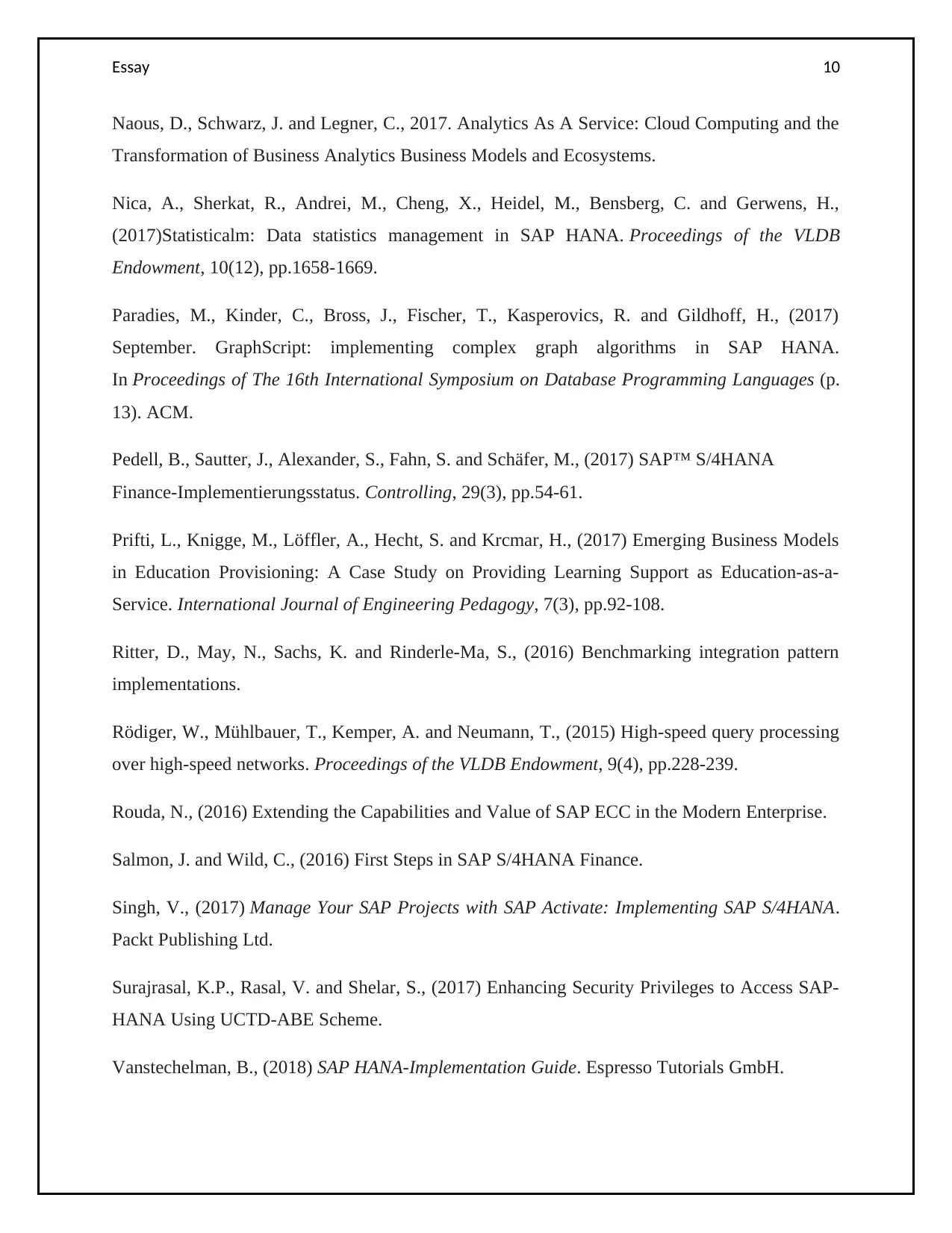
Essay 10
Naous, D., Schwarz, J. and Legner, C., 2017. Analytics As A Service: Cloud Computing and the
Transformation of Business Analytics Business Models and Ecosystems.
Nica, A., Sherkat, R., Andrei, M., Cheng, X., Heidel, M., Bensberg, C. and Gerwens, H.,
(2017)Statisticalm: Data statistics management in SAP HANA. Proceedings of the VLDB
Endowment, 10(12), pp.1658-1669.
Paradies, M., Kinder, C., Bross, J., Fischer, T., Kasperovics, R. and Gildhoff, H., (2017)
September. GraphScript: implementing complex graph algorithms in SAP HANA.
In Proceedings of The 16th International Symposium on Database Programming Languages (p.
13). ACM.
Pedell, B., Sautter, J., Alexander, S., Fahn, S. and Schäfer, M., (2017) SAP™ S/4HANA
Finance-Implementierungsstatus. Controlling, 29(3), pp.54-61.
Prifti, L., Knigge, M., Lö ffler, A., Hecht, S. and Krcmar, H., (2017) Emerging Business Models
in Education Provisioning: A Case Study on Providing Learning Support as Education-as-a-
Service. International Journal of Engineering Pedagogy, 7(3), pp.92-108.
Ritter, D., May, N., Sachs, K. and Rinderle-Ma, S., (2016) Benchmarking integration pattern
implementations.
Rö diger, W., Mühlbauer, T., Kemper, A. and Neumann, T., (2015) High-speed query processing
over high-speed networks. Proceedings of the VLDB Endowment, 9(4), pp.228-239.
Rouda, N., (2016) Extending the Capabilities and Value of SAP ECC in the Modern Enterprise.
Salmon, J. and Wild, C., (2016) First Steps in SAP S/4HANA Finance.
Singh, V., (2017) Manage Your SAP Projects with SAP Activate: Implementing SAP S/4HANA.
Packt Publishing Ltd.
Surajrasal, K.P., Rasal, V. and Shelar, S., (2017) Enhancing Security Privileges to Access SAP-
HANA Using UCTD-ABE Scheme.
Vanstechelman, B., (2018) SAP HANA-Implementation Guide. Espresso Tutorials GmbH.
Naous, D., Schwarz, J. and Legner, C., 2017. Analytics As A Service: Cloud Computing and the
Transformation of Business Analytics Business Models and Ecosystems.
Nica, A., Sherkat, R., Andrei, M., Cheng, X., Heidel, M., Bensberg, C. and Gerwens, H.,
(2017)Statisticalm: Data statistics management in SAP HANA. Proceedings of the VLDB
Endowment, 10(12), pp.1658-1669.
Paradies, M., Kinder, C., Bross, J., Fischer, T., Kasperovics, R. and Gildhoff, H., (2017)
September. GraphScript: implementing complex graph algorithms in SAP HANA.
In Proceedings of The 16th International Symposium on Database Programming Languages (p.
13). ACM.
Pedell, B., Sautter, J., Alexander, S., Fahn, S. and Schäfer, M., (2017) SAP™ S/4HANA
Finance-Implementierungsstatus. Controlling, 29(3), pp.54-61.
Prifti, L., Knigge, M., Lö ffler, A., Hecht, S. and Krcmar, H., (2017) Emerging Business Models
in Education Provisioning: A Case Study on Providing Learning Support as Education-as-a-
Service. International Journal of Engineering Pedagogy, 7(3), pp.92-108.
Ritter, D., May, N., Sachs, K. and Rinderle-Ma, S., (2016) Benchmarking integration pattern
implementations.
Rö diger, W., Mühlbauer, T., Kemper, A. and Neumann, T., (2015) High-speed query processing
over high-speed networks. Proceedings of the VLDB Endowment, 9(4), pp.228-239.
Rouda, N., (2016) Extending the Capabilities and Value of SAP ECC in the Modern Enterprise.
Salmon, J. and Wild, C., (2016) First Steps in SAP S/4HANA Finance.
Singh, V., (2017) Manage Your SAP Projects with SAP Activate: Implementing SAP S/4HANA.
Packt Publishing Ltd.
Surajrasal, K.P., Rasal, V. and Shelar, S., (2017) Enhancing Security Privileges to Access SAP-
HANA Using UCTD-ABE Scheme.
Vanstechelman, B., (2018) SAP HANA-Implementation Guide. Espresso Tutorials GmbH.
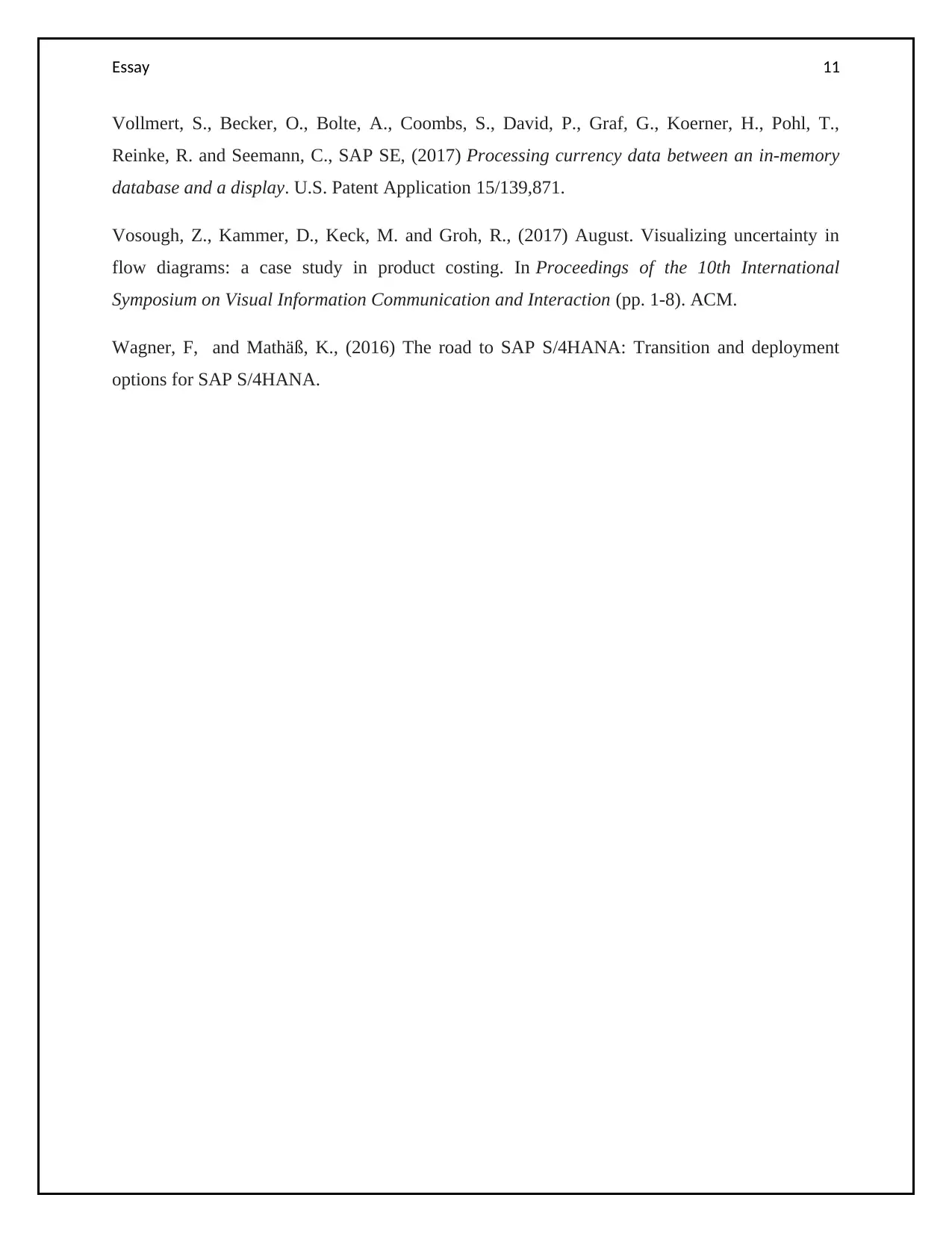
Essay 11
Vollmert, S., Becker, O., Bolte, A., Coombs, S., David, P., Graf, G., Koerner, H., Pohl, T.,
Reinke, R. and Seemann, C., SAP SE, (2017) Processing currency data between an in-memory
database and a display. U.S. Patent Application 15/139,871.
Vosough, Z., Kammer, D., Keck, M. and Groh, R., (2017) August. Visualizing uncertainty in
flow diagrams: a case study in product costing. In Proceedings of the 10th International
Symposium on Visual Information Communication and Interaction (pp. 1-8). ACM.
Wagner, F, and Mathäß, K., (2016) The road to SAP S/4HANA: Transition and deployment
options for SAP S/4HANA.
Vollmert, S., Becker, O., Bolte, A., Coombs, S., David, P., Graf, G., Koerner, H., Pohl, T.,
Reinke, R. and Seemann, C., SAP SE, (2017) Processing currency data between an in-memory
database and a display. U.S. Patent Application 15/139,871.
Vosough, Z., Kammer, D., Keck, M. and Groh, R., (2017) August. Visualizing uncertainty in
flow diagrams: a case study in product costing. In Proceedings of the 10th International
Symposium on Visual Information Communication and Interaction (pp. 1-8). ACM.
Wagner, F, and Mathäß, K., (2016) The road to SAP S/4HANA: Transition and deployment
options for SAP S/4HANA.
⊘ This is a preview!⊘
Do you want full access?
Subscribe today to unlock all pages.

Trusted by 1+ million students worldwide
1 out of 12
Related Documents
Your All-in-One AI-Powered Toolkit for Academic Success.
+13062052269
info@desklib.com
Available 24*7 on WhatsApp / Email
![[object Object]](/_next/static/media/star-bottom.7253800d.svg)
Unlock your academic potential
Copyright © 2020–2025 A2Z Services. All Rights Reserved. Developed and managed by ZUCOL.





